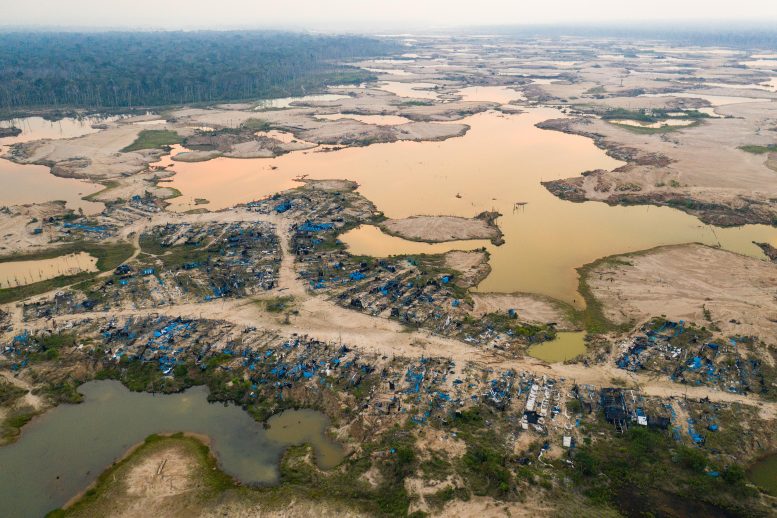
A former mining camp shows where shallow mining ponds have overwhelmed a former river system in the La Pampa region of Madre de Dios, Peru. Credit: Photo by Jason Houston (iLCP Redsecker Response Fund/CEES/CINCIA)
Deforestation and water quality improved following intervention in the Madre de Dios Region of the Amazon.
Artisanal and small-scale gold mining is a lifeline for many who live in Madre de Dios, a region in southeastern Peru, where poverty is high and jobs are scarce. However, the economic development in this part of the Amazon basin comes at a cost, as it causes deforestation, build-up of sediment in rivers, and mercury contamination in nearby watersheds, threatening public health, Indigenous peoples, and the future of the biodiversity hotspot. And much of the mining activity is unauthorized.
Government Intervention: Operation Mercury
Seeking to eliminate illegal artisanal and small-scale gold mining activity and its many negative impacts, the Peruvian government deployed “Operation Mercury” (Operation Mercurio) in February 2019 in the La Pampa region, an area where gold mining is banned in most places. La Pampa straddles the Interoceanic Highway. North of the highway, mining is mostly legal in mining concessions. However, south of the highway mining is strictly prohibited in the buffer zone of the Tambopata National Reserve.
Through Operation Mercury, armed military and national police were dispatched to the region and had a sustained presence until March 2020. Miners were evicted and mining equipment was destroyed. The intervention was successful in stopping illegal gold mining activity in La Pampa but activity in legal areas spiked, triggering many of the same environmental concerns, according to a Dartmouth-led study. The results were recently published in Conservation Letters, a journal of the Society for Conservation Biology.
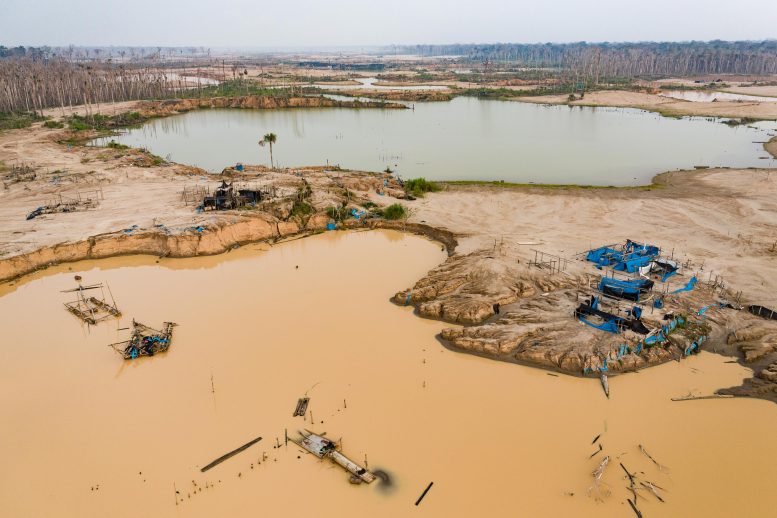
Mining equipment and shallow mining ponds show where a forest has been desolated in the La Pampa region of Madre de Dios, Peru. Credit: Photo by Jason Houston (iLCP Redsecker Response Fund/CEES/CINCIA)
“Although illegal gold mining operations in La Pampa came to a near halt during Operation Mercury’s two intervening years (2019-2020), mining activity essentially just shifted across the road to legal areas on the other side of the Interoceanic Highway,” says lead author Evan Dethier, an assistant professor of geology at Occidental College, who conducted the study while he was a postdoctoral fellow at Dartmouth.
Post-Intervention Environmental Changes
Following Operation Mercury, mining decreased by 70% to 90%. Excavated mining pits (“mining ponds”) in illegal mining areas decreased by up to 5% per year as compared to increasing by 33% to 90% per year before the intervention. Although deforested areas experienced revegetation at a rate of 1 to 3 square kilometers per year, progress was offset by increases in deforestation in legal mining areas north of the Interoceanic Highway at a rate of 3 to 5 square kilometers per year. Most of the revegetation occurred on the edges of deforested areas, with the highest revegetation in La Pampa south. Mining pond areas outside intervention zones also saw increases ranging from 42% to 83%
“The spillover effect in areas near the intervention zone demonstrates that stronger regulations are also needed in legal gold mining areas, to help mitigate the environmental effects,” says Dethier. “But this intervention did have some of the intended effects, limiting mining in a protected area for a sustained period.”
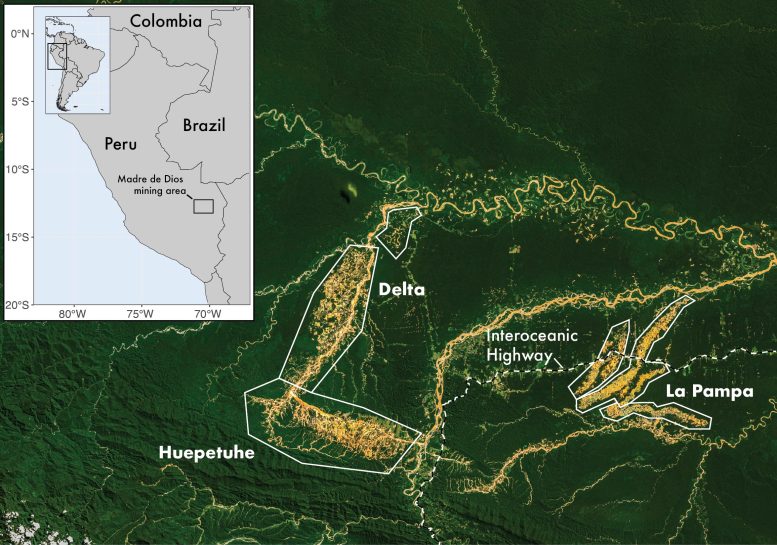
Map showing major mining areas in Madre de Dios, Peru. Heavily mechanized mining that utilizes earth-moving vehicles predominates in Delta and Huepetuhe, while minimally mechanized mining relying on suction pumps and human labor is used almost exclusively in La Pampa. The areas in La Pampa south of the Interoceanic Highway were the target of Operation Mercury in February 2019. Credit: Figure compiled by Evan Dethier, Image: NASA/USGS via Landsat 8 in 2019
Research Methodology
To assess Operation Mercury’s impact on mining activity, the research team drew on satellite data from 2016 to 2021 from the European Space Agency’s Sentinel-1 and Sentinel-2. Data were obtained from nine mining areas: four illegal mining areas targeted by the intervention, two legal areas to the north on the other side of the Interoceanic Highway, and three distant sites that were not part of the enforcement, which served as a control for the study. Using the radar and multispectral data, the researchers were able to quantify changes in water, water quality, mining pond areas, and deforestation in La Pampa following Operation Mercury, by comparing data from before, during, and after the intervention.
As part of the analysis, the team examined the spectral properties of the mining ponds and changes in pond color. Mining ponds typically take on a yellow color, which acts as a marker for gold mining activity. The “yellowness” of the ponds is associated with increases in suspended sediment in the water, according to prior research led by Dethier.
Through gold mining processes, sediment is churned up from the land, creating turbid water with lower reflectance levels, while clearer water has higher reflectance. After Operation Mercury was implemented, reflectance increased in mining ponds in La Pampa south but then stabilized.
Following Operation Mercury, pond yellowness decreased rapidly after mining activity was suspended in all areas of La Pampa, except in the north. In La Pampa northwest, mining activity spiked and pond yellowness increased by 43%, as compared to before the intervention. In La Pampa northeast, yellowness remained stable due to continued mining activity.
Final Thoughts and Broader Implications
“Like many other countries around the world with highly prized natural resources, with Peru’s rich deposits of gold, it has had to determine who controls this extractable resource and how this particular mining sector will be formed,” says co-author David A. Lutz, a research assistant professor in the Department of Environmental Studies at Dartmouth.
By January 2023, when this paper was under review by the journal, illegal gold mining had resumed in protected areas, as enforcement and anticorruption activities by the military and national police had ceased, once they were redeployed to focus on the COVID-19 pandemic.
“Our results demonstrate how intervention at the federal level can effectively stop illegal mining in Peru,” says Dethier. “But that is just one aspect of the problem, as a multifaceted approach is necessary to address the long-term impacts of both illegal and legal gold mining activity on humans, wildlife, and the environment in the Madre de Dios watershed.”
Dethier says that “strong governance and conservation and remediation strategies are needed to protect this tropical biodiversity hotspot. And, as we continue to show in our related work, this challenge is a global phenomenon.”
Dethier, Lutz, and others just published a related study that showed the rise of similar mining operations in 49 countries across the global tropics. They showed that as much as 7% of large tropical rivers have been degraded by these expanding mining operations.
Reference: “Operation mercury: Impacts of national-level armed forces intervention and anticorruption strategy on artisanal gold mining and water quality in the Peruvian Amazon” by Evan N. Dethier, Miles R. Silman, Luis E. Fernandez, Jorge Caballero Espejo, Sarra Alqahtani, Paúl Pauca and David A. Lutz, 19 September 2023, Conservation Letters.
DOI: 10.1111/conl.12978

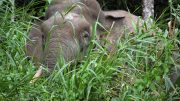

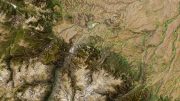
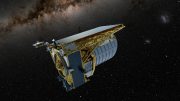

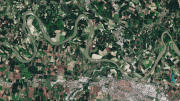


The real tragedy here is that the use of mercury is an anachronism, and generally isn’t needed to increase recovery. Also, the usual practice is to release the gold from the mercury amalgam by heating in the open air. Using a retort, in a closed system, the mercury can be recovered and re-used, avoiding contamination of the environment and increasing the profit of the artisanal miners. If the government would educate the miners, they would earn more money and not pollute their surroundings. The government could offer a service of doing the retorting either for free, or a negligible fee.